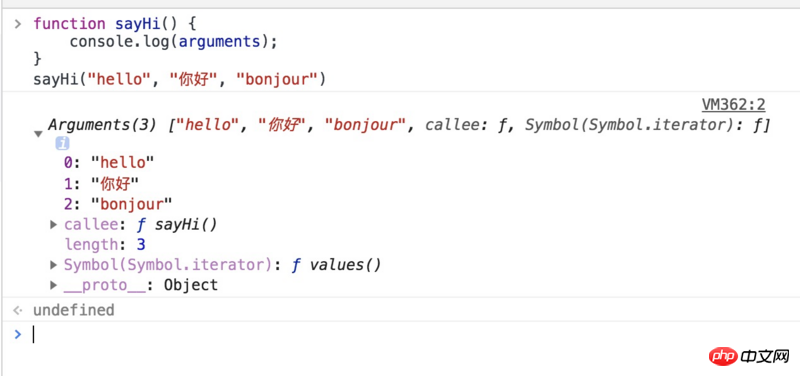ホームページ >ウェブフロントエンド >jsチュートリアル >JavaScriptのarguments関数を詳しく解説(例付き)
JavaScript の関数は、いくつかの点で他のオブジェクト指向言語とは異なります。
#関数のオーバーロードはありません
function foo(num) {
console.log(num + 100)
}
function foo(num) {
console.log(num + 200)
}
foo(100); // 300同じ名前の 2 つの関数が js で定義されている場合、その名前は後で定義された関数にのみ属します。 2. 引数クラスの配列関数の引数オブジェクトは、すべての (アロー以外の) 関数で使用できるローカル変数であり、配列のようなオブジェクトです。引数オブジェクトを使用すると、関数内で関数の (実際の) パラメーターを参照できます。 function foo() {
console.log(arguments);
}
foo(1, "foo", false, {name: "bar"}); // [1, "foo", false, object]
function foo() {
console.log(typeof arguments);
}
foo(1, "foo", false, {name: "bar"}); // object
#3. 引数の属性
function foo(num1, num2, num3) {
console.log(arguments)
}
foo(1); // [1]
length 属性は渡すことを示します。関数が宣言されたときの仮パラメータの数ではなく、関数の実際のパラメータの数を入力します。
calleecallee は関数自体を表し、関数内の callee を通じてそれ自体を呼び出すことができます。
4. 真の配列への変換
function sayHi() {
console.log(Array.prototype.slice.call(arguments, 0))
}
sayHi("hello", "你好", "bonjour") //["hello", "你好", "bonjour"]
function sayHi() {
console.log(Array.prototype.splice.call(arguments, 0));
}
sayHi("hello", "你好", "bonjour") //["hello", "你好", "bonjour"]
function sayHi() {
console.log(Array.from(arguments));
}
sayHi("hello", "你好", "bonjour") //["hello", "你好", "bonjour"]
function sayHi(...arguments) {
console.log(arguments);
}
sayHi("hello", "你好", "bonjour") //["hello", "你好", "bonjour"]
// 严格模式
function foo(a, b) {
"use strict";
console.log(a, arguments[0]);
a = 10;
console.log(a, arguments[0]);
arguments[0] = 20;
console.log(a, arguments[0]);
b = 30;
console.log(b, arguments[1])
}
foo(1);
输出:
1 1
10 1
10 20
30 undefined
// 非严格模式
function foo(a, b) {
console.log(a, arguments[0]);
a = 10;
console.log(a, arguments[0]);
arguments[0] = 20;
console.log(a, arguments[0]);
b = 30;
console.log(b, arguments[1]);
}
foo(1);
输出:
1 1
10 10
20 20
30 undefined
以上がJavaScriptのarguments関数を詳しく解説(例付き)の詳細内容です。詳細については、PHP 中国語 Web サイトの他の関連記事を参照してください。